Bmsc207 - Study guides, Class notes & Summaries
Looking for the best study guides, study notes and summaries about Bmsc207? On this page you'll find 40 study documents about Bmsc207.
All 40 results
Sort by
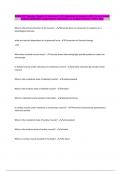
-
BMSC207 Muscles Chapter 12 Lectures 17-25 | Questions & Answers (100 %Score) Latest Updated 2024/2025 Comprehensive Questions A+ Graded Answers | 100% Pass
- Exam (elaborations) • 37 pages • 2024
-
- $13.48
- + learn more
BMSC207 Muscles Chapter 12 Lectures 17-25 | Questions & Answers (100 %Score) Latest Updated 2024/2025 Comprehensive Questions A+ Graded Answers | 100% Pass
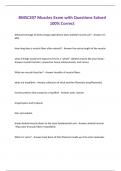
-
BMSC207 Muscles Exam with Questions Solved 100% Correct
- Exam (elaborations) • 43 pages • 2024
-
- $13.49
- + learn more
What percentage of daily energy expenditure does skeletal muscle use? - Answer 15- 60% How long does a muscle fiber often extend? - Answer the entire length of the muscle what 4 things would one expect to find in a "whole" skeletal muscle like your bicep - Answer muscle fascicles, connective tissue, blood vessels, and nerves
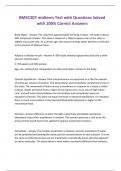
-
BMSC207 midterm Test with Questions Solved with 100% Correct Answers
- Exam (elaborations) • 39 pages • 2024
-
- $13.49
- + learn more
Body Water - Answer If 1L=1kg then approximately 42/70 kg is water. The body is about 60% composed of water. This value is based on a 70kg European man so the value is slightly inaccurate now. As a person ages the amount of body water declines as well due to the amount of adipose tissue. Adipose v skeletal muscle - Answer A: 90% lipids (mostly triglycerides) and only a small amount of body water S: 75% water and 18% protein Age, sex, and body fat composition can alter total water content ...
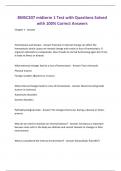
-
BMSC207 midterm 1 Test with Questions Solved with 100% Correct Answers
- Exam (elaborations) • 48 pages • 2024
-
- $13.49
- + learn more
Homeostasis and disease - Answer External or internal change can affect the homeostasis which causes an internal change and results in loss of homeostasis. If organism attempts to compensate, then it leads to normal functioning again but if not, it leads to illness or disease What external changes lead to a loss of homeostasis - Answer Toxic chemicals Physical trauma Foreign invaders (Bacteria or viruses)
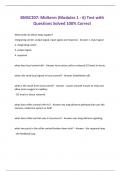
-
BMSC207: Midterm (Modules 1 - 6) Test with Questions Solved 100% Correct
- Exam (elaborations) • 61 pages • 2024
-
- $13.49
- + learn more
What order do these steps happen? integrating center, output signal, input signal and response - Answer 1. input signal 2. integrating center 3. output signal 4. response what does local control do? - Answer turns active cells to reduced O2 levels in tissue. what cells send local signals in local control? - Answer Endothelial cells what is the result from local control? - Answer - causes smooth muscle to relax and allow more oxygen to capillary - O2 levels in tissue restored
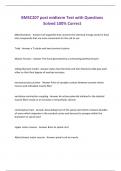
-
BMSC207 post midterm Test with Questions Solved 100% Correct
- Exam (elaborations) • 18 pages • 2024
-
- $12.99
- + learn more
Mitochondrion - Answer Cell organelle that converts the chemical energy stored in food into compounds that are more convenient for the cell to use Triad - Answer a T tubule and two terminal cisterns Muscle Tension - Answer The force generated by a contracting skeletal muscle sliding filament model - Answer states that the thick and thin filaments slide past each other so that their degree of overlap increases
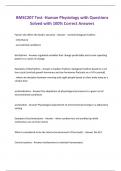
-
BMSC207 Test -Human Physiology with Questions Solved with 100% Correct Answers
- Exam (elaborations) • 24 pages • 2024
-
- $12.99
- + learn more
Factors the affect the body's set point - Answer - normal biological rhythms - inheritance - accustomed conditions biorhythms - Answer regulated variables that change predictably and create repeating patterns or cycles of change
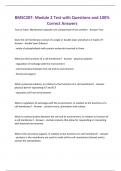
-
BMSC207- Module 2 Test with Questions and 100% Correct Answers
- Exam (elaborations) • 19 pages • 2024
-
- $12.99
- + learn more
True or False. Membranes separate one compartment from another - Answer True Does the cell membrane consist of a single or double layer and what is it made of? - Answer - double layer (bilayer) - made of phospholipids with protein molecules inserted in them What are the functions of a cell membrane? - Answer - physical isolation - regulation of exchange with the environment - communication between the cell and its environmen
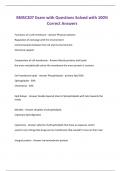
-
BMSC207 Exam with Questions Solved with 100% Correct Answers
- Exam (elaborations) • 16 pages • 2024
-
- $12.99
- + learn more
Functions of a cell membrane - Answer Physical isolation Regulation of exchange with the environment Communication between the cell and its environment Structural support Composition of cell membrane - Answer Mostly proteins and Lipids the more metabolically active the membrane the more protein it contains
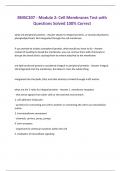
-
BMSC207 - Module 2: Cell Membranes Test with Questions Solved 100% Correct
- Exam (elaborations) • 22 pages • 2024
-
- $12.99
- + learn more
what are peripheral proteins - Answer attach to integral proteins, or loosely attached to phospholipid head. Not integrated through the cell membrane if you wanted to isolate a peripheral protein, what would you have to do - Answer instead of needing to break the membrane, you can remove them with chemicals to disrupt the bonds that's causing them to remain attached to the membrane are lipid-anchored proteins considered integral or peripheral proteins - Answer integral. still integrated i...

Do you wonder why so many students wear nice clothes, have money to spare and enjoy tons of free time? Well, they sell on Stuvia! Imagine your study notes being downloaded a dozen times for $15 each. Every. Single. Day. Discover all about earning on Stuvia


